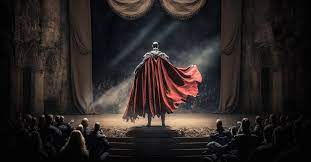D&D 5e offers the Actor feat for characters skilled in duplicity and imitation. This accomplishment makes it easier for your character to take on many personalities, mimic voices, and fit in with other groups. The Actor Feat 5e accomplishment is broken out as follows:
In Dungeons & Dragons 5th Edition, the Actor feat is a character enhancement option that provides various benefits related to deception, mimicry, and social interaction. To take the Actor feat, a character must have a Charisma score of 13 or higher.
Unveiling the Actor Feat 5e in D&D

- Charisma 13 or above is required.
- When trying to pass for someone else, you get an advantage on the Charisma (Performance) and Charisma (Deception) tests.
- You can imitate other people’s speech patterns or animal noises. The individual or the creature’s sound must be audible to you for at least 60 seconds. An opponent’s Charisma (Deception) check can refute a successful Wisdom (Insight) check, allowing a listener to discern that the effect is false.
- Furthermore, if you know the language, you may flawlessly replicate the speech patterns and accent of a creature you hear speak for at least a minute, passing for a native speaker and making yourself appear from that specific area.
The advantages of the actor
Enhancements to charisma and charisma when pretending to be someone else are the main advantages of the actor feat. Characters involved in espionage, covert operations, or any other scenario where deception and disguise are crucial can benefit from this.
Imitating speech can help you hear the sounds of other living things. The ability to mimic the sounds of specific people or animals could open up new avenues for espionage or bargaining. Examining the wisdom of the person you’re listening to is crucial for achieving accomplishment.
Being someone else gives you an edge when it comes to passing tests to keep your identity a secret. Staying hidden or fitting in with a certain group is a breeze with this.
After absorbing a living being’s conversation for some time, characters are capable of flawlessly imitating its speech patterns and distinctive dialect. This may be appreciated by characters who are trying to fit in with specific cultural or geographical settings.
There are ideas for growing your characters
Actor feats are often utilized by Actors and rogues. Being capable of conjuring up tricks and fitting in could make all the difference when joining a rival group, a criminal organization, or a prestigious court.
Actor Feat helps characters involved in espionage, surveillance, or assassination missions. Working secretly is easier with the advantage of mimicking voices and evading notice.
The Actor Feat can aid characters on diplomatic missions in integrating culturally. Being able to communicate in multiple languages can be beneficial when dealing with animals that speak different dialects.
There are possibilities for role-playing
The actor skill opens up a lot of possibilities for role-playing. Characters are capable of successfully assuming multiple identities to join in on intricate social interactions, form alliances, or cause trouble. Furthermore, it cultivates imagination and problem-solving abilities as players must navigate through scenarios where deception and disguises are crucial.
Conclusion
The Actor feat can be customized to best suit the story and tone of the campaign by Dungeon Masters. Players and DMs need to discuss how the Actor feat will be used in the particular campaign, just as they would with any other feat.
FAQs
Q: What are the prerequisites for taking the Actor feat in D&D 5e?
The Actor feat requires a character to have a Charisma score of 13 or higher.
Q: How do the advantages of Charisma (Performance) and Charisma (Deception) check work?
When attempting to pass for someone else, the character with the Actor feat gains an advantage on Charisma (Performance) and Charisma (Deception) checks. This means they roll two d20s and take the higher result.
Q: Can the mimicry ability of the Actor feat imitate any sound?
The character can imitate other people’s speech patterns or animal noises. The sound must be audible to them for at least 60 seconds. However, the Dungeon Master has discretion in determining what sounds are reasonable for imitation.
Q: How does the interaction between Wisdom (Insight) and Charisma (Deception) checks work about mimicry?
An opponent can make a Charisma (Deception) check against a successful Wisdom (Insight) check to discern that the mimicry effect is false.

Hi! this is sheryas iyar,
I am not a “gamer boy”. I am a gamer. I play video games. I don’t take slutty pictures while holding a controller.

